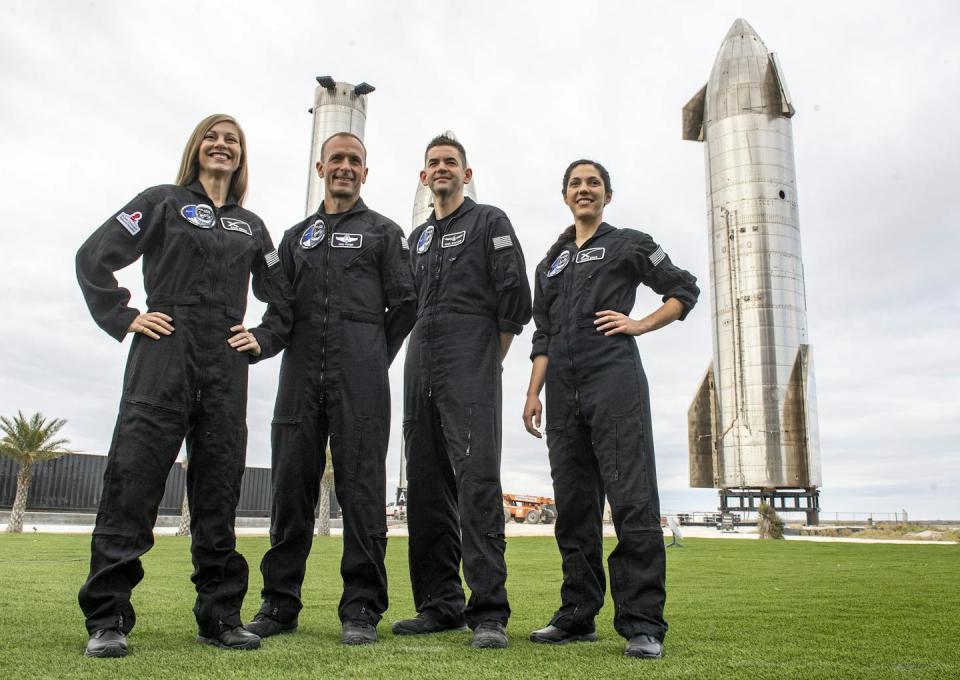SpaceX’s upcoming Polaris Dawn mission aims to be historic in more ways than one. Not only does Polaris Dawn plan to orbit the Earth higher than any astronaut has in more than 50 years, it also plans to conduct the first private spacewalk.
The mission was scheduled to launch on August 27, 2024, but after a helium leak was discovered, SpaceX delayed the launch date by 24 hours to the morning of August 28.
It will include a crew of four: mission commander Jared Isaacman; Scott Poteet, a 20-year veteran Air Force pilot; and SpaceX employees Anna Menon and Sarah Gillis. They will launch on a Falcon 9 rocket and travel in a SpaceX Dragon capsule called Resilience.

As a space policy expert, I see this mission as an important step in the development of commercial space travel. If successful, this mission will demonstrate that private companies are working to develop the capabilities needed to go to the moon or Mars.
Commercial space flight
Polaris Dawn’s time in space will be spent testing communications between it and Earth via Starlink satellites and completing nearly 40 experiments. Many of these experiments will study how the human body responds in low-gravity environments and measure the radiation the capsule receives.
But Polaris Dawn’s biggest task will be its first private spacewalk. The spacewalk will test SpaceX’s new extravehicular activity suits, or EVA suits, and learn how they function in the low-gravity environment of space.
Polaris Dawn isn’t the first commercial spaceflight mission SpaceX has launched. In addition to providing launch services to NASA, SpaceX also sells flights on its Falcon 9 rocket and Dragon crew capsule to individuals and companies.
SpaceX’s first commercial mission, Inspiration4, launched in 2021. The mission was led by Isaacman, commander of Polaris Dawn.
After that mission, Isaacman purchased three additional flights from SpaceX and partnered with the company to launch the Polaris program. While neither Isaacman nor SpaceX has released exact figures, seats on the Dragon have previously sold for around $55 million.
Polaris Dawn is just the first of three planned Polaris missions. While few details have been released about the second, the third mission will be the first launch of SpaceX’s Starship with humans on board.
High flying track
Given SpaceX’s ambitions to conduct its own missions to the Moon and Mars, it will need to develop and test many of the elements that such missions require. It will need to design and test EVA suits, complete longer missions that mimic the time it takes to reach places like the Moon, and demonstrate the ability to communicate with Earth.
Polaris Dawn’s high orbit will bring humans farther from Earth than they have been in more than 50 years.
At its peak, Polaris Dawn is expected to reach an orbit more than 850 miles (1,367 kilometers) from Earth. That’s more than twice the distance between Earth and the International Space Station, which orbits about 254 miles (408 km) up. It will also be the highest orbit humans have reached since the Apollo program sent astronauts to and from the moon.
Testing new suits
Perhaps more importantly, the spacewalk will test SpaceX’s new EVA suits. Developing these suits is perhaps one of the most difficult tasks to accomplish.
NASA learned early on that spacesuits are incredibly cumbersome. They must provide life support and protection from the space environment while still allowing astronauts to move. This is especially difficult because fully pressurized suits are bulky and difficult to move around in, leading to exhaustion.
NASA developed its current generation of EVA suits in the 1980s. This summer, NASA canceled several spacewalks due to suit discomfort and coolant leaks.
The crew of Polaris Dawn is expected to conduct its extraterrestrial activities on August 30. To do so, they will lower their orbit to about 434 miles (700 km) to reduce the crew’s exposure to radiation.
All four crew members of Polaris Dawn will prepare for the spacewalk. After the entire capsule is deflated, two crew members – Isaacman and Gillis – will leave the relative safety of the Dragon capsule to spend about two hours in space.
A charity
Polaris and Polaris Dawn aim to raise money for childhood cancer research while expanding SpaceX’s space exploration capabilities. As a tech billionaire, Isaacman has a long history of philanthropy.
Like Isaacman’s previous Inspiration4 mission, Polaris Dawn is raising money for St. Jude Children’s Research Hospital. In one case, donations were solicited in exchange for Doritos chips designed specifically for space.


Isaacman’s dedication to tying this mission to his philanthropy suggests that he understands the criticisms many people have of the so-called billionaire space club. These arguments often include the idea that billionaires like Elon Musk and Jeff Bezos would help people more by spending their money on things like fighting poverty rather than on space missions.
While these types of private missions are not funded by taxpayer dollars and do not require public support, Isaacman’s decision to partner with St. Jude creates tangible and direct benefits on Earth.
Like much of SpaceX’s business, Polaris Dawn is ambitious, but necessary to the company’s future plans. Before SpaceX can run to Mars, it must first walk—or spacewalk, to be more precise.
This article was updated on August 27, 2024 to reflect the delayed launch.
This article is republished from The Conversation, a nonprofit, independent news organization that brings you facts and reliable analysis to help you understand our complex world. It was written by: Wendy Whitman Cobb, Air University
Read more:
Wendy Whitman Cobb is an affiliate of the US School of Advanced Air and Space Studies. Her views are her own and do not necessarily reflect the views of the Department of Defense or any of its constituent entities. Mention of trade names, commercial products, or organizations does not imply endorsement by the U.S. Government, and the appearance of external hyperlinks does not constitute an endorsement by DoD of the linked websites or the information, products, or services contained therein.